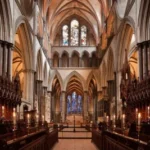Salisbury Cathedral is also home to one of Britain’s greatest and most famous organs, built in 1877 by Father Henry Willis (1821-1901). The instrument consists of 61 ranks and 65 stops, 4 manuals and a pedal, with two main cases on the north and south sides of the soundboard and an additional case for the 32-foot pedal pipes in the north transept. An 1898 issue of The Musical Times in a supplement entitled “Portrait of Henry Willis” discussed the origin of Henry Willis’ nickname “Father” Willis. Similarities were found between Henry Willis and Father Bernard Smith, an organ builder to the king in the 17th century. The article from the publication was written as follows:
Two hundred years ago there lived in this country a great organ maker whose instruments were a credit to their maker. His two nephews were connected with him in his business. Partly to distinguish him from his younger relatives, but especially as a mark of appreciation of his great ability and artistic merit, he was canonized (sic), so to speak, with the title of ‘Father’. His name is familiar enough in the history of organ building – Father Henry Willis is assisted by a younger generation who have two sons – Vincent and Henry – in his employ, in whom he has great confidence and hope. It is therefore natural that he, the greatest organ maker of the Victorian era, should be known as Father Willis.
The Willis Construction Company also had several inventions and patents that helped pave the way for modern organ manufacturing as we know it today. Some of these include:
- Thumb pistons – patented 1851.
- Barker keyed pneumatic lever – innovative use, 1851.
- Pneumatic stop – patented 1851.
- Radially concave pedal board – invented 1855.
- Angle stops – invented 1855.
- Simple tubular pneumatic key – 1867.
- Tubular pneumatic key for divided organ – 1872.
- “Servo-pneumatic” or “floating” pneumatic lever with key action – patented 1884.
- Electro-pneumatic key – innovative use, 1885.
- Fully pneumatic key mechanism with pneumatic clutch – patented 1889.
- Fully adjustable thumb pistons – patented 1882.
Father Willis’s scaling system did not rely on the usual halving ratios, and so it was possible to create and sound rows of flues with a smooth “power curve” across the compass. Many firms have attempted to copy these scales by careful measurement, but have failed. They are closely guarded secrets, with only their closest advisers having access to them.
High-pressure reed sound, particularly some 16-inch wind-pressure tubas, have been a specialty throughout the history of the Willis company. Many have hailed the organ as the finest Willis organ ever made. A contemporary statement by Oxford professor of music Sir Frederick Ouseley in a letter to Salisbury organist (in 1877) John Richardson read:
“I sincerely believe that you have the finest church organ in the world – certainly the finest in England – and I heartily congratulate you on the same. Father Willis himself later told Sir Walter Alcock, Salisbury organist from 1917 to 1947, that he considered the organ to be his best work to date. Very few changes have been made since its original construction, and almost all of the pipes are original and still cone tuned. Some minor changes to the instrument have included the following:

- Download Milan Digital Audio – Salisbury Cathedral Willis (HAUPTWERK)
- Original Publisher: Milan Digital Audio
- Format: HAUPTWERK
- Category: Sound Libraries
- License type: Full
- Download Size: 12.74 GB




